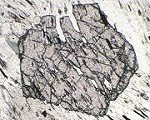Practical Aspects of Mineral Thermobarometry
Energy of mixing
Chemical potential and Activity
Read about chemical potential and its relationship to other thermodynamic variables in Spear, Ch 6, pp 138-141.
The thermodynamic properties of simple substances, such as the end members of solid solution series, can be measured or estimated. Natural minerals, however, are complex and can vary in composition. We need to bridge this gap, so that we can perform calculations on real phases using thermodynamic data on simple end members.
For most types of thermodynamic calculation it is convenient to define a standard state, so that thermodynamic quantities such as chemical potential can be divided into two parts: a standard state part, and a "real" part. The expression below for the chemical potential of a component (i) in an impure phase consists of the chemical potential of the component in its standard state, and a term which is composition-dependent, containing ai, the activity of component i.
Splitting up the chemical potential, and defining activity
µi = µ°i + RTlnai
The most convenient standard state for solids is the pure end member at the pressure and temperature of interest. The standard state chemical potential will be exactly equal to the molar Gibbs free energy of pure i, and will be a function of temperature and pressure only. The activity of pure i on this basis will be 1; the activity of an end member in an impure phase will be related to its mole fraction, and can be thought of as the composition correction to the free energy.
Activity-composition relationships
In what follows we assume ionic mixing on sites, i.e. that cations mix with others over particular crystallographic sites in a mineral structure.
One-site substitution
Where substitution occurs on one site per formula unit, e.g. (Ca, Mg, Fe) CO3
ai = Xigammai
where X is the mol fraction of component i and gamma is the activity coefficient.
Ideal and non-ideal solutions
In an ideal solution, the activity coefficient is 1, and so a = X. In non-ideal solutions, the activity coefficient will have some value greater or smaller than one, which will be a function of composition, temperature, and perhaps other variables. Solid solution series which show miscibility gaps at lower temperatures are clearly non-ideal. Non-ideal solutions are treated further in a later section. In practice the assumption of ideal behaviour may be adequate.
This page last modified 12 October 2004
